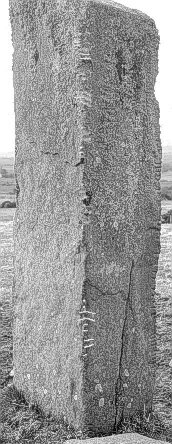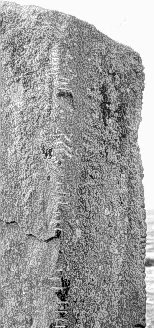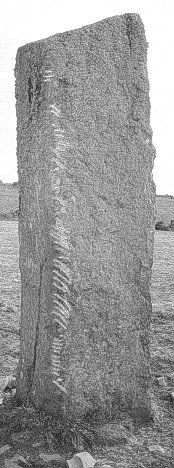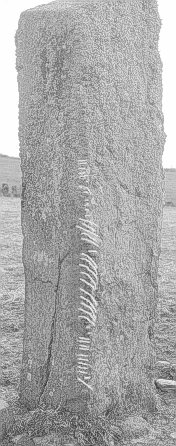According to Ferguson, PRIA 15, 1874, 201, this stone was found in April 1874 by one W.K. Dover in the farmlands of Breastagh, 350 yds. west of "Millaghnacross" (6"-map 6: Mullaghnacross) near by the road running from Killala to Foghill / Kilcummin, i.e. about 5 M from Aghaleague {9}. Ferguson underlines that the stone is located "centrally among several groups of Cromlechs, which are indicated in the same lands of Breastagh, and in the adjoining lands of Carbadmore and Rathfran" (cp. Rathfran Bay and Abbey). In OI, 58, Ferguson speaks of "the singularly Patrician character of its local surroundings", given that Foghill is "the site of the wood of Focluth", in the "immediate vicinity is Rathban, a residence of that Auley son of Fiachra, the contemporary of Patrick, from whom the barony takes its name", and "Fiersad Tresi, in which Tresi wife of Auley was drowned", etc.
Ferguson points to the fact that Rathfran "was undoubtedly a residence of Amalgaid, or Awley, the cotemporary of Patrick, from whom the barony takes its name, and in Foghill we probably have some trace, in its northern limits, of that wood of Fochlaidh, celebrated in all lives of the saint". He then reports about some further localities mentioned in the tradition about Amalgaid and his successors.
According to Macalister, Epig. 1, 75, "an old woman living close by told .. that this was the stone of King `Garbry' (sic), whose dwelling was at Summerhill, close by; that he was killed there one day when his wife was in Killala, and that she .. hastened to cross the inlet between Killala and Summerhill, but was drowned"; this is "probably a recollection of the fate of Tresi, wife of Amalgaid prince of Tirawley" [cp. Ferguson's indication of the legend as quoted above].
Ferguson visited the stone on Whit-Monday and Tuesday of the year mentioned and had it dug up. The inscription must originally have covered both edges of the Eastern surface.
Size according to Macalister, CIIC: 12'0" x 2'6" x 2'0".
Published photographs:
- Mc Manus, riu 11, 1986, pl. IIIa (right angle);
- Mc Manus, riu 11, 1986, pl. IIIb (left angle);
- Mc Manus, riu 11, 1986, pl. IV (right angle: fracture).
MAQ CORBRRI MAQ A* *
Two "oblique digits" follow after A1, representing either G or MM; the latter is preferrable because they show a double distance compared with the other strokes. Farther on, there follow "others certainly expressing LLA or LLO"; then a distance of 9" up to a "terminal T". This could well represent Amalgaid or a variant of this name, e.g. Amolngid as in Tirechÿn's annotations. So we would have to expect a vowel before the LL for which there is not enough space though. But the name occurs also in the form Amlongad according to Duald Mac Firbis, viz. in the "Genealogies of Saints". Could this AMMLLONGAD be meant here? The --letter does appear in another part of the inscription, so that AMMLLONGITT can be assumed. - This must be the second part of the inscription, the first one running on the other edge. Here we have possibly to read ERC as a part of SERC, name of the daughter of Cairbre; but only two B-strokes can be discovered, so that we can only arrive at reading LERC. As MAQI is missing in the inscription, we even cannot ascertain the direction of the writing. The following proposals are possible:
top-down, from right of arris: LASCENGED[U]LC
top-down, from left of arris: DACSENGEL[U]DS
bottom-up, from right of arris: CL[U]DENGESCAL
bottom-up, from left of arris: SD[U]LENGESCAD
The last one is the most probable reading. -S could be the rest of a once preceding name ending in -IAS, possibly ERCIAS. - This is the first example of the --letter contained in an inscription. - In the position of U there is space enough for some more notches. - An alternative solution could start from the Anglo-Saxon name Egilbert, but Awley has to be preferred. - Ferguson points to Fothad Airgthech (Compert Mongÿin), because the inscription stood "on the end which was in the ground". - Until Ferguson's time, this was the northernmost Ogham stone found in Ireland and the only one found in Mayo.
Western arris, up:
**SDULENGESCAD*
"In another reading downward the word ENGEL emerges; but there is nothing definite to guide the course of the transliteration."
Northern arris:
MAQCORRBRIMAQAMMLLO[NGI]TT
Maq Corrbri Maq Ammlo[ngi]tt
"The inscription purports to commemorate some descendant of a Coirbre, son of Auley." - "Auley's name is variously spelled: Amalgaid, Amolugid, and Amlongad. In the last form it appears to survive on the Breastagh pillar."
This was still "the only known Ogham inscription in West Connacht" when Macalister published Epig. 1. His reading dates from the 26.6.1896.
Left:
è::ãððãææææãêèâì:ââææäèåãñ::ãêèîíìææêéâ
Le/iG(a?)G[o...o]SADiULENGeSQ(a?)d/q-n/sa
"It seems .. probable that the i is the end of one word and the u the beginning of the next. In this case -sadi would be the end of a name in the genitive, and the initial legg- may well be some form of lige "grave".
Right:
ïâîíîìòñòñçòñåäïâîíâïïèèãòñâííâ
MAQCORRBRIMAQAMMLLORATTA
"On the right-hand arris the only doubtful letters are ra, near the top of the stone; but this reading seems .. more in accordance with indications than the ngi of the previously published transcript." - "The late forms maq and Lloratta are against the tempting reading maq Corrbri maqamm Lloratta, taking maqamm as a partitive genitive plural"; reading Ammlloratta, "the second name is at least unusual".
The Breastagh ogham commemorates "Eolaing (gen. Iulenge) son of Coirpre son of Amolngaid. As this ogham stands in Tirawley (T¡r Amolngado), Eolaing was presumably grandson of the king from whom that territory was named, Amolngaid king of Connacht, who died between 440 and 450. His son Coirpre, according to the genealogies (BB 107b15), was ancestor of St. Tigernÿn. In the pedigrees of saints (BB 217b329), St. Tigernÿn is descended from another Coirpre, son of another Amolngaid, of the same generation as king Amolngaid, and related to him. If we add two generations, the death of Eolaing should have occurred early in the sixth century at latest. The late Ogham form maq occurs twice on this monument."
dexter:)
L[E]GG[...............]SD[...]LEESCAD
The gap between GG and SD leaves "room for about 15 scores". For the second gap, the "most likely restoration is IU". The "beginning is badly damaged by spalling, to all appearance with intention".
Sinister:
MAQ CORRBRI MAQ AMML[L]OITT
Macalister gives a similar reference to Amalgaid, of whose name "Amlongad is an early form", and "as the king had a son, Coirpre, it is quite likely that this stone is actually a monument of a member of his family".
Interpretation Korolev, DP, 60 ("10b" only:)
MAQ CORRBRI MAQ AMMLOITT
Of the left side of the inscription, only a few single groups of strokes have been preserved. Note the apocopated forms, pointing to the middle of the 6th century (?).
"Right angle" above fracture:
MAQ AMMLLO...DT
[p. 22:] "The eroded of fractured part covers a space of approximately 15cm, beginning after the O, and is approx. 3cm deep at its deepest point. .. At the upper end there is a single vowel notch (all that remains of an original I?) followed by a possible T, then by a certain T .. the "original reading might well have been ONGITT" but "OGETT .. is also a possibility." [Fn. 30]: "Only two strokes (D) can be seen clearly but there is room for a third at the beginning of the symbol."
"Left angle":
There is a "very clear example of symbol 13", i.e., ñ, "but the name in question is unclear. Three vowel notches are discernible before the L of LENGESCAD, but there is a gap of some 17cm between these and the preceding D. MacNeill here read IULENGE (`Notes' 332), ignoring the final SCAD. That or D[UN]ULENGE (= MS D£nlang) would be evidence for the value /ž/" of ñ, "but again this is pure conjecture and the SCAD must be ignored for both readings."
Reading Gippert (3.4.1996):
 Dexter-up:
Dexter-up:
]L[.O]G[O........]S(DA)[..]ULE[.]O[ VC..
â]è[.ã]ð[ââ.........]êè(ìâ)[..]äèåãñ[.]ã[.éîì..
â]çç[.ââ]ïï[ââ...............]çççç(ë)ë(â)[....]âââççââââïïï[.]ââ[.çç]ç[ëë]ëë..
Although much less can be read than what seemed possible to Macalister, at least the rarely attested -letter can be ascertained, cf. figs.  15 and
15 and  18. At least one stroke of the D in the middle of the inscription resembles an M-score, crossing the angle nearly as far as the S-strokes below it. Before and after the
18. At least one stroke of the D in the middle of the inscription resembles an M-score, crossing the angle nearly as far as the S-strokes below it. Before and after the  first element, some vowel notches seem visible, but these cannot be relied upon. Perhaps we have a LUG- name here.
first element, some vowel notches seem visible, but these cannot be relied upon. Perhaps we have a LUG- name here.
 Sinister-up:
Sinister-up:
MAQ CORRBRI M(A)Q AMML(L)[OG...](T)[
ïâîíæîìãòñòñçòñåäæï(â)îíæâïïè(è)[ãð...](í)[
ïâëëëëëëëëëââïïïïïïïïïïçïïïïïâââââï(â)ëëëëëâïïçç(çç)[ââïï.....](ëëë)[
In order for the upper part of the inscription to be readable in detail, a lot of litchen would have to be removed; cp. figs.  9 and
9 and  1. Just the crucial point of this part of the inscription, an -letter again, could not be verified in any way, only two M-strokes being visible at best. Instead of Macalister's -ITT any other sequence of vowels plus H-letters, e.g. ADD, is possible.
1. Just the crucial point of this part of the inscription, an -letter again, could not be verified in any way, only two M-strokes being visible at best. Instead of Macalister's -ITT any other sequence of vowels plus H-letters, e.g. ADD, is possible.
For attestations of Awley in the Vita Tripartita cf. the ed. Mulchrone, 79 sq., l. 1449 ff. (ms. Egerton). Here we find the following written variants:
Amolgada (1449), Amalgada (1450), Amalg/ada/ (1453), Amal/gada/ (1460); Coirpre (1452). But also: Fedeilm ingen Amalgaid (1513 Egerton as against Amalgada R; 1522 E has Amalgada again). 1540 E Amalg/ada/; 1541 Luid hi Forraig macc nAmalgodo R, nAmalgaid E, 1542 filii Amalgodo R, Amalgada E. 1556 within a verse: im secht maccu Amalgada; - 1558: Êi Amalg/ada/ E, ±u Amalgaid R; 1579: filios Amalg/ada/ E, Amalgaid R; 1609 f.: Macc Ercae macc Draigin qui hi Cill R¢e M¢re est hi cr¡ch Amalgada (Amalgaid R, Amalgad/h/a E). - Occurrences of Amlongaid in Genealogies (sub Lagin): Rawl. B. 502 117b 47 m. Mÿel-doborchon; Lec. add.: m. Bearaig m. Muireadaig m. Amlongaid. ib. 51 Rawl.: m. Amalgada (the same Awley is meant here, cp. the variants. - Rawl. 120a 32: Tr¡ meic Cainnig: S‚tna, Connad, Amlo&127;ngaid (variants Amlomaid LL, Amlongad Lec., Amlaib BB.); LL 317c 45: Cethri meic Mane Mÿil: Amlo&127;ngaid, Tuathal Tigech .. (var. Amalgaid Lec., BB).
Additional literature:
- Rhys, JRSAI 28, 1898, 233;
- Macalister, PRIA 34, 1919, 402.
Last changes of this record: 15.04.97
Copyright Jost Gippert, Frankfurt a/M 1996. No parts of this document may be republished in any form without prior permission by the copyright holder.  Dexter-up:
Dexter-up: 15 and
15 and  18. At least one stroke of the D in the middle of the inscription resembles an M-score, crossing the angle nearly as far as the S-strokes below it. Before and after the
18. At least one stroke of the D in the middle of the inscription resembles an M-score, crossing the angle nearly as far as the S-strokes below it. Before and after the  first element, some vowel notches seem visible, but these cannot be relied upon. Perhaps we have a LUG- name here.
first element, some vowel notches seem visible, but these cannot be relied upon. Perhaps we have a LUG- name here. Sinister-up:
Sinister-up: 9 and
9 and  1. Just the crucial point of this part of the inscription, an -letter again, could not be verified in any way, only two M-strokes being visible at best. Instead of Macalister's -ITT any other sequence of vowels plus H-letters, e.g. ADD, is possible.
1. Just the crucial point of this part of the inscription, an -letter again, could not be verified in any way, only two M-strokes being visible at best. Instead of Macalister's -ITT any other sequence of vowels plus H-letters, e.g. ADD, is possible.















